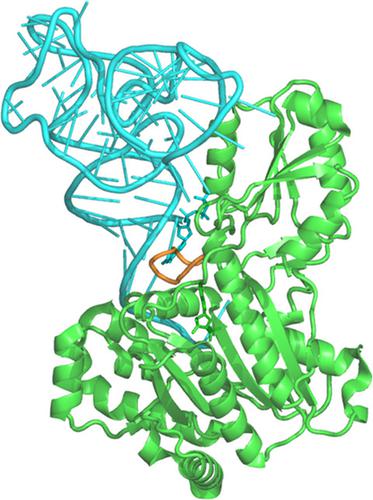当前位置:
X-MOL 学术
›
FEBS Lett.
›
论文详情
Our official English website, www.x-mol.net, welcomes your feedback! (Note: you will need to create a separate account there.)
Coding triplets in the tRNA acceptor‐TΨC arm and their role in present and past tRNA recognition
FEBS Letters ( IF 3.5 ) Pub Date : 2021-01-18 , DOI: 10.1002/1873-3468.14044 Ilana Agmon 1, 2 , Itay Fayerverker 3 , Tal Mor 3
FEBS Letters ( IF 3.5 ) Pub Date : 2021-01-18 , DOI: 10.1002/1873-3468.14044 Ilana Agmon 1, 2 , Itay Fayerverker 3 , Tal Mor 3
Affiliation

|
The mechanism and evolution of the recognition scheme between key components of the translation system, i.e., tRNAs, synthetases and elongation factors, are fundamental issues in understanding the translation of genetic information into proteins. Statistical analysis of bacterial tRNA sequences reveals that for six amino acids, a string of 10 nucleotides preceding the tRNA 3'end, carries cognate coding triplets to nearly full extent. The triplets conserved in positions 63-67 are implicated in the recognition by the elongation factor EF-Tu, and those conserved in positions 68-72, in the identification of cognate tRNAs and their derived minihelices by class IIa synthetases. These coding triplets are suggested to have primordial origin, being engaged in aminoacylation of prebiotic tRNAs and in the establishment of the canonical codon set.
中文翻译:

tRNA 受体-TΨC 臂中的编码三联体及其在当前和过去 tRNA 识别中的作用
翻译系统关键组成部分(即tRNA、合成酶和延伸因子)之间识别方案的机制和演变是理解遗传信息向蛋白质翻译的基本问题。细菌 tRNA 序列的统计分析表明,对于 6 个氨基酸,tRNA 3' 端之前的 10 个核苷酸串几乎全部携带同源编码三联体。在位置 63-67 保守的三联体涉及延长因子 EF-Tu 的识别,而在位置 68-72 保守的三联体涉及通过 IIa 类合成酶识别同源 tRNA 及其衍生的小螺旋。这些编码三联体被认为具有原始起源,参与了益生元 tRNA 的氨酰化和规范密码子集的建立。
更新日期:2021-01-18
中文翻译:

tRNA 受体-TΨC 臂中的编码三联体及其在当前和过去 tRNA 识别中的作用
翻译系统关键组成部分(即tRNA、合成酶和延伸因子)之间识别方案的机制和演变是理解遗传信息向蛋白质翻译的基本问题。细菌 tRNA 序列的统计分析表明,对于 6 个氨基酸,tRNA 3' 端之前的 10 个核苷酸串几乎全部携带同源编码三联体。在位置 63-67 保守的三联体涉及延长因子 EF-Tu 的识别,而在位置 68-72 保守的三联体涉及通过 IIa 类合成酶识别同源 tRNA 及其衍生的小螺旋。这些编码三联体被认为具有原始起源,参与了益生元 tRNA 的氨酰化和规范密码子集的建立。



























 京公网安备 11010802027423号
京公网安备 11010802027423号